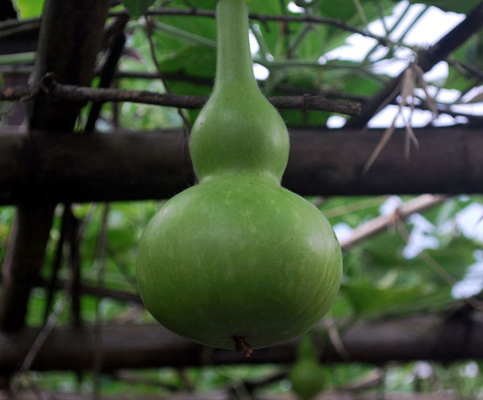The Delicious & Crafty Bottle Gourd

Not familiar with a bottle gourd? How about it's other names – calabash, opo squash, lauki, or long melon? Let's take a look at what makes up this oddly named veggie.
What is it?
The bottle gourd is grown on a vine, similar to a pumpkin, and can be harvested early in the year as a food, or much later as a utensil. Yes, once matured, the inside of this squash becomes tough and loses its flavor, so the only thing left to do is hollow out the vessel and use the mature, dried casing as a bottle, utensil, or pipe.
History
A commonly known cultivated plant, bottle gourds are usually found in tropical and subtropical areas. Their origins are believed to be from Africa, around the Zimbabwe region, while other experts claim Asia should be listed as the country of origin. The bottle gourds which are found in these regions, growing wild, generally have a thinner wall and would not do well in shipment, but are still easily molded into utensils by the experienced tribes. Present-day bottle gourds owe their thick, waterproof wall to the experts who domesticated this versatile plant.
Health Benefits
Cooked bottle gourd, or lauki, is a calming, soothing food that acts as a diuretic. Extremely low in calories and high in dietary fiber, cooked bottle gourd makes an excellent food for people who are dieting. After eating a healthy portion of cooked lauki, your stomach is full and your whole body feels relaxed; and if you're dieting, you will appreciate those feelings. You can enjoy large portions of cooked bottle gourd without worrying about counting calories.
You'll notice I keep saying “cooked bottle gourd.” That's because you don’t want to eat the vegetable raw as it could harm the stomach and digestive system, causing ulcers, or worse. Like other members of the gourd family, the bottle gourd contains the tetracyclic triterpenoid cucurbitacins compound, which is responsible for the bitter taste. This bitter taste should let people know that it is poisonous, but raw 'calabash juice' has been touted by weight loss hucksters as a miracle drink. Just be aware that drinking raw, uncooked 'calabash juice' or eating raw bottle gourd is dangerous to your health. Once cooked, the bottle gourd becomes harmless and quite tasty, offering more than enough health benefits to keep anyone on a weight loss program happy.
Fun Facts
The bottle gourd was one of the first cultivated plants in the world, grown not for food but as a container. It was primarily used as utensils, such as cups, bowls, and basins, mostly in rural areas. It can be used for carrying water, or can be made for carrying items, such as fish, dirt, or other food. In some Caribbean countries it is worked, painted, and decorated as shoulder bags or other items by artisans, and sold to tourists. You are probably most familiar with it as a highly decorated bird nest, often hung from large poles.
In Jamaica there is also a reference to the natural lifestyle of Rastafarians using the gourd to make a rattle of sorts for musical festivities. As a cup, bowl, or even water-pipe, the bottle gourd is considered consistent with the 'Ital' or natural lifestyle of not using refined products such as table salt, or using modern cooking methods, such as microwaves. In Haiti the plant is called 'kalbas kouran' literally meaning "running calabash", and is used to make the sacred rattle emblematic of the Vodou priesthood, called an "asson". The bottle gourd plant is highly respected in many areas, so much so that the bottle gourd happens to be the national tree of St. Lucia.
How to eat
The calabash, as a vegetable, is frequently used in Asian cuisine as either a stir-fry or in a soup. In Burma, young leaves are also boiled and eaten with spicy hot fermented fish sauce called Nga peet. And in Central America seeds of the bottle gourd are toasted and ground with other ingredients (including rice, cinnamon, and allspice) to make horchata, a popular drink of the region.
In other cultures, this gourd is cooked just like a summer squash and enjoyed with a variety of toppings including butter and brown sugar. Often connected with Indian cooking and spices, the bottle gourd is very typically surrounded with warm, spicy aromas.
If you have never tried bottle gourd, today just might be your lucky day. See if any specialized grocery stores in your area offer this delicacy. Then, after you are done with it, you get to have a craft project to play with. Decorate the outside skin, then use it for a bird feeder in your own back yard. How about that? Dinner and entertainment all wrapped up in one thick-walled gourd.
| Pattern Categories Browse the categories to help you find the patterns you're looking for. |
||







